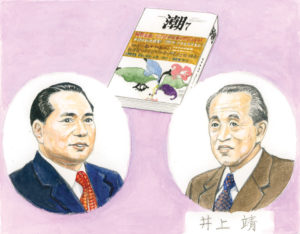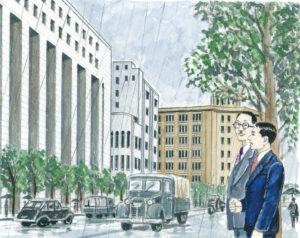Chapter Summary

Illustration courtesy of Seikyo Press.
In June 1975, Shin’ichi Yamamoto focused especially on conferences for top Soka Gakkai leaders in each ward in Tokyo as well as other regions in the country to propel the organization into the new century. At these meetings, new goals were presented, such as building new centers and conducting various commemorative events.
On July 3, at a meeting signifying the 30th anniversary of second Soka Gakkai President Josei Toda’s release from prison, Shin’ichi spoke of Mr. Toda’s visionary ideal of global citizenship, saying, “I am resolved to realize his grand vision for world peace as long as I live, giving it my all” (The New Human Revolution, vol. 22, p. 19).
In addition, the youth commemorated the establishment of both the young men’s and young women’s divisions in July with a Seikyo Shimbun panel-discussion series titled “Josei Toda As Seen by the Youth.” This series brimmed with the passion of young people resolved to open a new era with their mentor.
Shin’ichi also began having exchanges with the Japanese journalist and writer Yasushi Inoue. Their discussions were published in the Soka Gakkai-affiliated monthly magazine Ushio, under the title “Letters of Four Seasons,” starting with the July 1975 issue. Their discussion, published in 12 installments, covered a wide range of topics and was later published as a book in 1977, followed by an English edition in 1980.
Shin’ichi also befriended and enjoyed many encounters with legendary industrialist Konosuke Matsushita, founder of the Panasonic Corporation, Japan’s largest consumer electronics company. The two men discussed issues ranging from people and their lives to the path forward for Japan and the world. Their dialogue was published in October 1975 as Jinsei mondo (Questions and Answers About Life).
Unforgettable Scene

Illustration courtesy of Seikyo Press.
A Pledge to the Mentor: The Cornerstone of Soka Gakkai Centers
From around 1975, the Soka Gakkai began developing its community centers. Whenever Shin’ichi Yamamoto thought of Soka Gakkai facilities, he would recall an unforgettable exchange with his mentor, Josei Toda, that took place in 1949 when his businesses were in dire straits.
One day, Josei Toda and Shin’ichi Yamamoto were walking toward Hibiya in central Tokyo. As rain poured down, they had no umbrellas and could not hail a cab. Looking at his mentor soaked to the skin, Shin’ichi felt a sharp pang in his heart. The headquarters building of the Supreme Commander for the Allied Powers towered before them. Looking up at the impressive edifice, Shin’ichi said: “Sensei, I’m so sorry you have to wait like this in the cold. In the future, I’m going to buy a car that you can be driven around in. I’ll also build magnificent facilities for kosen-rufu. You can count on me.”
Mr. Toda deeply sensed his disciple’s earnest resolve and smiled happily. (NHR-22, 5–6)
■ ■ ■
Mr. Toda hoped to build a large, spacious headquarters for the members as soon as possible, and he felt very bad about his inability to do so. Unaware of his feelings, some leaders complained that things were hopelessly inconvenient without a dedicated headquarters building, and that a fine structure that would astonish the public should be constructed without delay. Mr. Toda responded firmly: “We don’t need a building. That’s just a superficial thing. Wherever I am is the headquarters! That should be good enough, shouldn’t it? Spend more time thinking about strengthening our organization first.”
Whenever he heard Mr. Toda say something like that, Shin’ichi silently pledged: “Sensei, I’ll do my best. I’ll see to it that we have a full-time headquarters building where everyone feels free to gather.”
In November 1953, when the Soka Gakkai headquarters was established in Shinano-machi in Tokyo’s Shinjuku Ward, Mr. Toda was as gleeful as a child. …
“I’d like to build Soka Gakkai facilities like this throughout Japan,” Mr. Toda said to Shin’ichi.
Shin’ichi engraved those words in his heart. And today, there are numerous magnificent facilities, much larger than that original headquarters, in many places throughout Japan. (NHR-22, 7–8)
Key Passage
The mentor–disciple relationship is not mere formality or lip service—it only exists when disciples constantly have their mentor in their hearts. Self-discipline and independence arise from having a mentor in one’s heart. (NHR-22, 7)
You are reading {{ meterCount }} of {{ meterMax }} free premium articles

